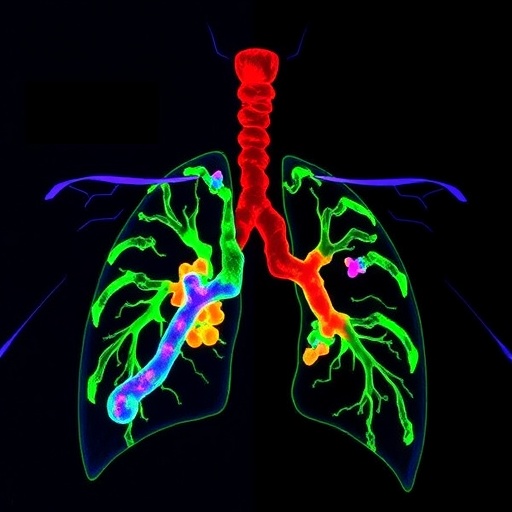In the relentless battle against non-small-cell lung cancer (NSCLC), a new molecular revelation is shedding light on the troubling phenomenon of resistance to tyrosine kinase inhibitors (TKIs), drugs that have revolutionized treatment but are often undermined by the cancer’s adaptive defenses. Recent research published in BMC Cancer uncovers a critical epigenetic modification pathway involving METTL16, a methyltransferase enzyme, that modifies the mRNA of glutathione peroxidase 4 (GPX4) through N6-methyladenosine (m6A), linking the suppression of ferroptosis—a distinctive cell death pathway—to NSCLC’s stubborn resistance to the third-generation TKI, AZD-9291, also known as Osimertinib.
NSCLC remains one of the deadliest forms of cancer worldwide, accounting for a significant proportion of lung cancer cases and deaths annually. Despite important advances with targeted therapeutics such as EGFR-TKIs, treatment efficacy is frequently thwarted by the tumor cells’ ability to develop drug resistance. Understanding the molecular underpinnings of such resistance is crucial for improving patient outcomes. Researchers Zeng, Wang, Qiao, and colleagues have addressed this gap by investigating how METTL16-dependent m6A modifications on GPX4 mRNA influence NSCLC cell behavior and drug responsiveness.
At the heart of this discovery lies the m6A RNA modification, an epitranscriptomic hallmark that regulates gene expression post-transcriptionally by dynamically altering RNA stability, translation, and splicing. METTL16, one of the relatively understudied methyltransferases responsible for catalyzing m6A modifications, has now been implicated in the pathological progression of NSCLC through its substrate, GPX4. GPX4, known for its pivotal role in detoxifying lipid peroxides, serves as a key regulator of ferroptosis—a form of regulated cell death driven by iron-dependent lipid peroxidation, distinct from apoptosis or necrosis.
Bioinformatic analyses of The Cancer Genome Atlas (TCGA) and Gene Expression Omnibus (GEO) datasets revealed a marked upregulation of METTL16 expression in NSCLC tissues compared to adjacent noncancerous counterparts. More significantly, elevated levels of METTL16 correlated adversely with patient prognosis, indicating its potential role as a prognostic biomarker. These findings set the stage for experimental validation, where overexpression studies in NSCLC cell lines such as PC9 and HCC827 demonstrated enhanced proliferation and marked resistance to AZD-9291.
Experimental mechanistic investigations employed methylated RNA immunoprecipitation (MeRIP) assays to pinpoint GPX4 mRNA as a direct target of METTL16-mediated m6A modification. This modification was shown to stabilize GPX4 transcripts, ultimately elevating GPX4 protein levels. The increase of GPX4 conferred an anti-ferroptotic phenotype to NSCLC cells, effectively sheltering them from ferroptosis triggered by oxidative stress and thus facilitating survival despite TKI treatment. Intriguingly, knockdown of METTL16 reversed this effect, restoring ferroptosis sensitivity and diminishing tumor cell proliferation.
The dual-luciferase reporter assays further elucidated the functional interaction between METTL16 and GPX4 mRNA, confirming that m6A modification enhanced GPX4 expression at the translational level. Rescue experiments underlined this regulatory axis: NSCLC cells with suppressed METTL16 and reduced GPX4 expression became significantly more susceptible to ferroptosis induction and exhibited reinstated responsiveness to AZD-9291 treatment, underscoring the therapeutic potential of targeting this pathway.
Ferroptosis, as a mode of cell death, has recently gained traction for its potential exploitation in cancer therapy. It operates through the accumulation of iron-dependent lipid peroxides, thereby compromising membrane integrity. The suppression of ferroptosis via upregulated GPX4 activity represents a cancer cell’s cunning survival strategy to evade TKI-induced cytotoxicity. This study reveals that METTL16’s m6A modification of GPX4 is a critical molecular lever by which NSCLC cells modulate ferroptosis to foster drug resistance.
These findings open several avenues for translational applications. Therapeutic interventions aimed at inhibiting METTL16 activity may serve to destabilize GPX4 mRNA, enhance ferroptosis, and resensitize resistant NSCLC tumors to TKIs such as AZD-9291. Moreover, this METTL16-GPX4 axis represents a promising biomarker for predicting patient responses and tailoring precision medicine approaches to overcome resistance.
Furthermore, the elucidation of m6A RNA modification mechanisms in cancer provides a broader understanding of epigenetic regulation beyond DNA methylation and histone modifications. As m6A writers, readers, and erasers continue to be characterized, their roles in oncogene regulation and cancer cell adaptation introduce a burgeoning field of potential targets for novel cancer therapeutics.
While much of the current clinical focus centers on blocking EGFR mutations directly with TKIs, the uncovering of epitranscriptomic contributors to resistance such as METTL16 urges the scientific and medical communities to consider combination strategies that target both genetic and epigenetic pathways. This dual-targeted approach might delay or prevent the emergence of resistance, extending patient survival and improving quality of life.
Importantly, the study employed rigorous methodologies, including Western blot analyses to quantify protein expression changes, and functional assays that monitor cell survival and proliferation under drug treatment, lending robust support to the proposed molecular mechanism. Such integrative use of in silico data mining and wet-lab confirmation exemplifies the state-of-the-art approach in cancer biology research today.
The implications extend beyond NSCLC, as ferroptosis resistance and m6A RNA modifications are increasingly recognized in diverse cancer types. Understanding the universality or tumor-specific aspects of METTL16-mediated GPX4 regulation may catalyze a new wave of research into overcoming drug resistance more broadly.
Critically, while targeting METTL16 appears promising, further studies are required to assess potential off-target effects or toxicities in normal tissues where m6A modifications also play fundamental roles. The balance between therapeutic efficacy and safety remains a cornerstone of drug development.
In conclusion, this landmark study uncovers a previously unrecognized epitranscriptomic pathway by which METTL16-mediated m6A modification of GPX4 mRNA inhibits ferroptosis, promoting proliferation and AZD-9291 resistance in NSCLC. These insights offer a compelling new target for overcoming TKI resistance, marking a significant advance in the understanding and potential treatment of one of the deadliest cancers.
Subject of Research: Molecular mechanisms underlying NSCLC resistance to tyrosine kinase inhibitors, focusing on METTL16-mediated m6A modification of GPX4 and its role in ferroptosis regulation.
Article Title: METTL16-dependent GPX4 m6A modification links ferroptosis to NSCLC TKIs resistance.
Article References:
Zeng, Y., Wang, Q., Qiao, D. et al. METTL16-dependent GPX4 m6A modification links ferroptosis to NSCLC TKIs resistance. BMC Cancer 25, 1335 (2025). https://doi.org/10.1186/s12885-025-14729-1
Image Credits: Scienmag.com




